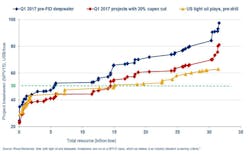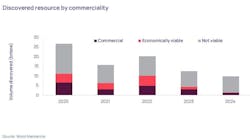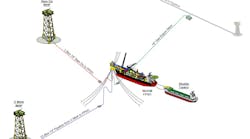Offshore staff
EDINBURGH/HOUSTON/SINGAPORE – According to a recent Wood Mackenzie report, a leaner and more cost-competitive deepwater industry is emerging from the downturn, with the most attractive projects now competing with US tight oil plays.
This year should see a noticeable pick-up in deepwater project sanctions, with three projects –Mad Dog Phase 2, Kaikias, and Leviathan – already fully approved.
The analyst firm estimates that on average global deepwater project costs have fallen just over 20% since 2014. Assuming a 15% internal rate of return hurdle (NPV15), 5 Bbbl of pre-sanction deepwater reserves now breakeven at $50/boe or lower.
By comparison, there are 15 Bbbl of tight oil resource in undrilled wells with breakevens of $50/boe or lower at a 15% hurdle rate in Wood Mackenzie’s dataset. However, the playing field between tight oil and deepwater is about to get a lot more level. There is still considerable scope to drive deepwater breakevens lower through leaner development principles and improved well designs, but in tight oil cost inflation is back with a vengeance.
Wood Mackenzie estimates that a further 20% cut in current deepwater costs would bring 15 Bbbl of pre-FID reserves into contention, on par with tight oil. The deepwater value proposition will strengthen as tight oil cost inflation returns. A 20% rise in tight oil costs would mean that the two resource themes effectively have the same opportunity set measured by volume in the money at $60/boe.
Angus Rodger, Asia-Pacific upstream research director at Wood Mackenzie, said: “We are at last beginning to see the first signs of recovery in deepwater, driven primarily by cost reduction and portfolio high-grading. Projects in theUS Gulf of Mexico in particular have made significant strides, with many reducing NPV15 breakevens from above $70/boe to below $50/boe.
“This is not just a result of cheaper rig day rates. Of far greater impact are the steps the industry in the Gulf of Mexico and elsewhere have taken to re-evaluate project designs and improve well performance. We are now seeing scaled-down projects emerge with less wells, more subsea tiebacks, and reduced facilities and capacities – and this all translates into lower breakevens.”
The slowdown has also changed the structure of the deepwater industry. While it is slowly getting leaner, it is also getting smaller. More than 70% of the 45 pre-FID projects targeting sanction over the next few years are operated by just eight companies – Brazil’s Petrobras and the seven majors (ExxonMobil, Chevron, Shell, BP, Total, Eni, and Statoil). This is due to the exit of many independents from the sector because of either cost pressure or a re-allocation of capital to tight oil plays.
In a capital-constrained world, fewer operators inevitably mean less deepwater projects flowing through to sanction. Only the most cost-competitive projects and regions will attract new investment.
03/30/2017



